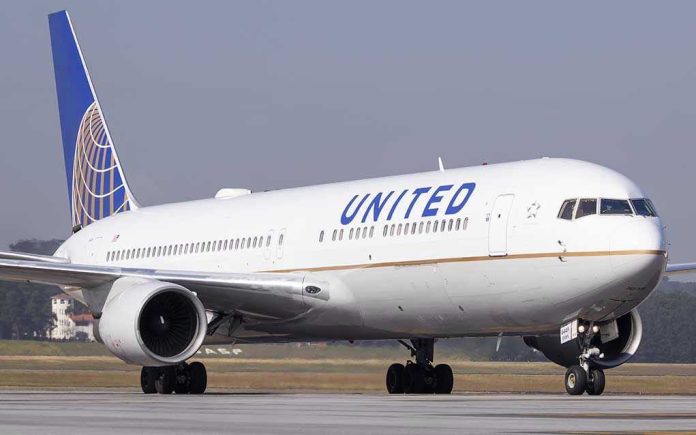
One passenger’s claim about a bomb hidden in his wife’s luggage forced a packed United jet to make an emergency landing, exposing just how vulnerable and reactive air travel remains—no matter how routine the route or familiar the flight.
Story Snapshot
- A United Airlines flight from Dallas to Chicago was diverted to St. Louis after a mid-air bomb threat.
- Passengers were evacuated, a suspect was arrested, and a bomb squad found no explosive device.
- The incident highlights persistent gaps in aviation security and the psychological toll on travelers.
- Authorities and airlines face renewed pressure to rethink emergency protocols and passenger screening.
Bomb Threat Turns Routine Flight Into Crisis
United Airlines Flight UA380, a standard Sunday morning flight from Dallas to Chicago, became a national headline after a male passenger’s alarming claim: there was a bomb in his wife’s luggage. Forty minutes after takeoff, the pilots did not hesitate. They declared a general emergency and diverted the Boeing 737-700 to St. Louis Lambert International Airport, a major Midwest hub prepared for emergencies but rarely tested in such dramatic fashion. Passengers, who moments earlier were anticipating a mundane trip, suddenly faced evacuation and the unnerving spectacle of a bomb and arson unit sweeping their plane.
The suspect, a 26-year-old man, was taken into custody immediately after landing. Authorities wasted no time, moving passengers to the airport’s B concourse while the aircraft was combed for explosives. No bomb was found, but the psychological impact lingered—the fear of a worst-case scenario, the memory of post-9/11 air travel, all rushing back in a moment of chaos. The quick, coordinated response by airport staff and law enforcement prevented physical harm, but the disruption was undeniable: delays rippled through the airport, and shaken travelers found themselves at the center of a national news cycle.
Why Bomb Threats Still Disrupt Modern Aviation
Bomb threats on commercial flights remain rare but deeply disruptive, raising perennial questions about the adequacy of security screening and the unpredictable behavior of passengers. The United incident comes amid a post-pandemic surge in air travel—and, according to industry observers, a rise in disruptive passenger behavior. While most bomb threats prove false, each emergency landing and evacuation exposes the thin line between routine travel and crisis. The incident echoes similar disruptions overseas, including a high-profile case in Merseyside, underscoring that aviation security concerns are not limited to any one country or airline.
Lambert St. Louis International Airport’s emergency response, led by director Rhonda Hamm-Niebruegge, showcased the best of crisis management: rapid evacuation, thorough searching, and clear communication. Yet the broader vulnerabilities remain. Even with decades of enhanced security protocols, one passenger’s words can still ground a flight, reroute hundreds, and trigger nationwide scrutiny. The debate now turns to whether airlines and airports can further tighten screening and identify red flags without sacrificing convenience or crossing into overreach.
United flight forced to make emergency landing in St Louis after passenger made bomb threat, report says | The Independent https://t.co/RtJBITyoV0
— FireandAviation TV (@FireandAviation) November 17, 2025
Stakeholders Under the Microscope
United Airlines, one of the nation’s largest carriers, must now balance public reassurance with operational lessons learned. Passengers and crew, the most directly affected, face not only disruption but a renewed sense of unease about what—if anything—could have been done differently. Airport authorities and law enforcement agencies, praised for their swift actions, are left to investigate the suspect’s motivations and determine whether current protocols are enough to deter future threats. The arrested passenger’s reasons remain unclear, but the incident has already prompted calls for a deeper examination of passenger screening and mental health assessment.
Power dynamics in such crises are clear: pilots and air traffic controllers make immediate operational decisions, airport directors coordinate ground response, and law enforcement holds the ultimate authority over investigation and security. Each stakeholder’s role is both distinct and interdependent, underscoring the complexity of modern aviation safety—and the challenges in preventing, rather than simply reacting to, such threats.
Impacts and Industry Repercussions
The immediate effects were tangible: grounded flights, delayed connections, and heightened anxiety among those on board. In the longer term, the incident rekindles debates over security, privacy, and the psychological cost of air travel in an era of heightened vigilance. Industry experts argue that rapid response and coordinated protocols are essential, but so too is a measured perspective: while dramatic, such threats remain statistically rare.
Policy makers and airlines now face renewed pressure to review not just technology and processes, but also the human element—how to detect and manage disruptive behavior before it escalates. The flying public, meanwhile, is left to absorb yet another reminder that even a routine flight can turn extraordinary in a moment. As the investigation unfolds and public attention shifts to the next headline, the lesson endures: aviation security is a moving target, and complacency is not an option.












